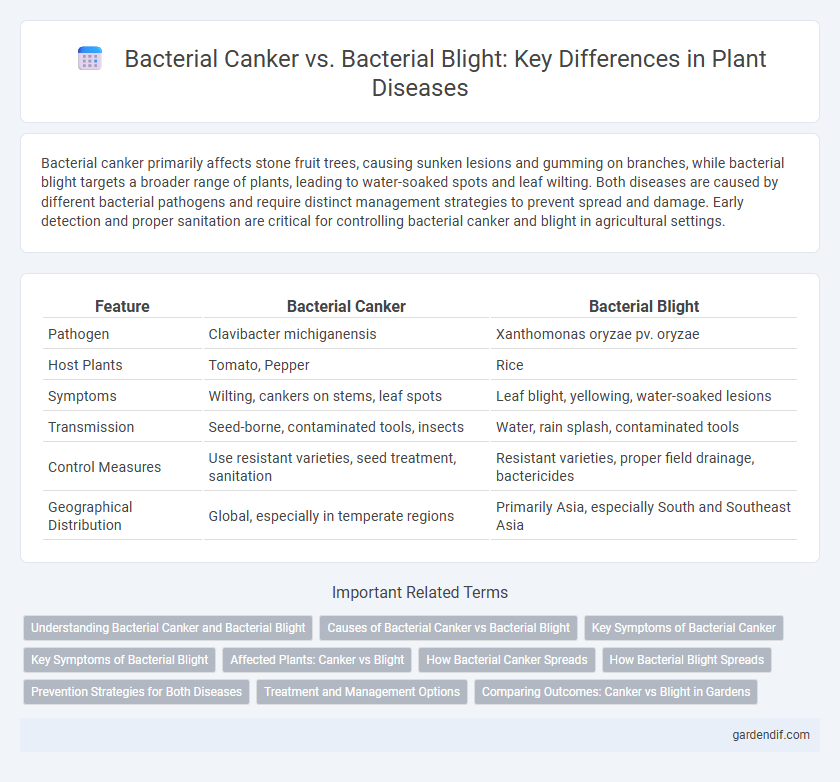
Bacterial canker vs Bacterial blight Illustration
Bacterial canker primarily affects stone fruit trees, causing sunken lesions and gumming on branches, while bacterial blight targets a broader range of plants, leading to water-soaked spots and leaf wilting. Both diseases are caused by different bacterial pathogens and require distinct management strategies to prevent spread and damage. Early detection and proper sanitation are critical for controlling bacterial canker and blight in agricultural settings.
Table of Comparison
| Feature | Bacterial Canker | Bacterial Blight |
|---|---|---|
| Pathogen | Clavibacter michiganensis | Xanthomonas oryzae pv. oryzae |
| Host Plants | Tomato, Pepper | Rice |
| Symptoms | Wilting, cankers on stems, leaf spots | Leaf blight, yellowing, water-soaked lesions |
| Transmission | Seed-borne, contaminated tools, insects | Water, rain splash, contaminated tools |
| Control Measures | Use resistant varieties, seed treatment, sanitation | Resistant varieties, proper field drainage, bactericides |
| Geographical Distribution | Global, especially in temperate regions | Primarily Asia, especially South and Southeast Asia |
Understanding Bacterial Canker and Bacterial Blight
Bacterial canker primarily affects stone fruit trees, causing sunken lesions on branches and wilting of shoots, and is caused by Pseudomonas syringae pv. syringae. Bacterial blight commonly targets beans and other legumes, characterized by water-soaked spots on leaves and pods, primarily caused by Xanthomonas phaseoli. Both diseases significantly impact agricultural productivity, necessitating accurate identification and management strategies to prevent crop losses.
Causes of Bacterial Canker vs Bacterial Blight
Bacterial canker is primarily caused by Clavibacter michiganensis subsp. michiganensis, affecting tomato and pepper plants through stem and fruit infections leading to wilting and dieback. Bacterial blight is mainly caused by Xanthomonas species, such as Xanthomonas oryzae in rice, and targets leaves and vascular tissues causing leaf spots and severe yield loss. Both diseases thrive in warm, humid conditions but differ in host specificity and infection pathways.
Key Symptoms of Bacterial Canker
Bacterial canker is characterized by sunken, dark brown lesions on stems and branches, often accompanied by gummy exudates oozing from affected areas. Leaves exhibit wilting, yellowing, and necrotic spots that may lead to defoliation. Fruit symptoms include water-soaked spots that turn brown and become sunken, severely impacting crop yield and quality.
Key Symptoms of Bacterial Blight
Bacterial blight manifests with water-soaked lesions on leaves that rapidly turn brown and necrotic, often surrounded by yellow halos. Leaves may exhibit angular spots that follow leaf veins, leading to extensive tissue death and defoliation. Infected stems and pods show dark, sunken cankers and ooze bacterial exudate, severely impacting plant vigor and yield.
Affected Plants: Canker vs Blight
Bacterial canker primarily affects stone fruit trees such as cherries, peaches, and plums, causing sunken lesions and dieback. Bacterial blight targets a wider range of plants including beans, rice, and cotton, leading to water-soaked spots, leaf necrosis, and wilting. Both diseases significantly reduce crop yield but differ in host specificity and symptom expression.
How Bacterial Canker Spreads
Bacterial canker primarily spreads through rain splash, contaminated pruning tools, and infected plant material, facilitating rapid transmission within orchards. It can also enter host plants via wounds or natural openings, increasing infection rates during wet conditions. Effective management relies on sanitation and controlling water dispersal to limit bacterial movement.
How Bacterial Blight Spreads
Bacterial blight spreads primarily through water splashes, rain, and overhead irrigation, transferring the Xanthomonas bacteria from infected plants to healthy ones. Contaminated tools, seeds, and human activities further facilitate the dissemination of the pathogen. Managing moisture and ensuring proper sanitation are critical to controlling bacterial blight outbreaks effectively.
Prevention Strategies for Both Diseases
Effective prevention of bacterial canker and bacterial blight involves rigorous sanitation practices, such as removing and destroying infected plant material and maintaining proper plant spacing to enhance air circulation. Applying copper-based bactericides during early growth stages can reduce bacterial populations, while selecting resistant cultivars further minimizes disease incidence. Regular monitoring and prompt elimination of diseased tissues prevent pathogen spread, ensuring healthier crops and improved disease management.
Treatment and Management Options
Bacterial canker treatment involves pruning infected branches and applying copper-based bactericides to reduce inoculum levels. Management of bacterial blight includes the use of copper sprays combined with resistant cultivars and strict sanitation practices to prevent spread. Both diseases require avoiding overhead irrigation and ensuring proper tree spacing to improve air circulation and minimize humidity.
Comparing Outcomes: Canker vs Blight in Gardens
Bacterial canker causes localized lesions and sunken, dead areas on branches, often leading to dieback and significant structural damage in fruit trees. Bacterial blight presents as water-soaked spots on leaves that rapidly expand, causing leaf wilting, defoliation, and reducing overall plant vigor. Gardens affected by canker tend to suffer long-term damage with slow recovery, while blight results in quicker symptom development but can be managed effectively with timely intervention.
Bacterial canker vs Bacterial blight Infographic

 gardendif.com
gardendif.com